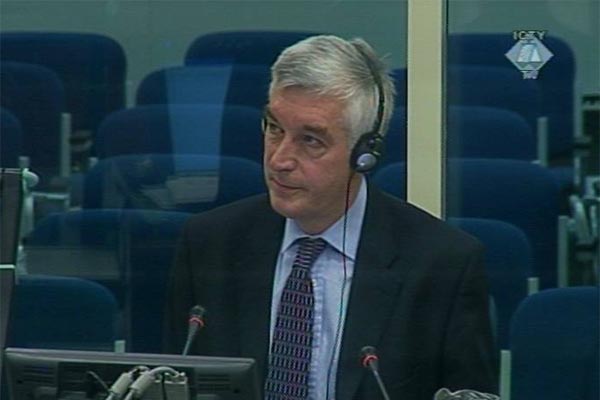Home
FORENSIC REPORTS FROM SREBRENICA
British pathologist John Clark takes the stand at the trial for the Srebrenica and Zepa crimes. Clark headed the forensic team conducting the post mortem examinations of the Srebrenica victims exhumed from mass graves between 1999 and 2001
 John Clark, witness in the trial of the former military and police officials charged with the Srebrenica genocide
John Clark, witness in the trial of the former military and police officials charged with the Srebrenica genocide British pathologist John Clark was the head of the forensic team that conducted the post mortem examinations of the Srebrenica victims in 1999, 2000 and 2001. The bodies were exhumed from the mass graves in Kozluk, Konjevic Polje, Glogova, Lazete, and Zeleni Jadar and in the Ravnice region.
The prosecution tendered his report into evidence today at the trial of seven Bosnian Serb military and police officers charged with the crimes in Srebrenica and Zepa. In the brief examination-in chief, the prosecution merely got from John Clark details about the scope and type of forensic analyses applied by his team. The British pathologist confirmed that he had conducted the post mortem examination of the bodies found in mass graves and supervised the work of 22 forensic experts - pathologists and anthropologists – whose findings are contained in the report.
The autopsies were conducted primarily to identify the victims and determine the injuries they had sustained and the cause of death. Doctor Clark's team examined some 1,100 to 1,500 bodies; on the average, each body had three gunshot wounds. The cause of the injuries was determined by the damage to the bones, because the exhumed bodies had already decomposed.
The British pathologist explained that because there was no “soft tissue" – it is easier to determine the cause of injuries on soft tissue – his team had to rely on the anthropologists. They analyzed the type of damage on the bones and helped the pathologists determine how the injuries had been inflicted and what weapon had been used.
In the cross-examination, the defense counsel tried to show that Doctor Clark's report was biased, claiming it was motivated by the data he had gotten from the prosecution, which in turn only wanted to support indictments that had already been issued.
The counsel representing the seven officers quoted parts of the report that, in their view, indicate that some of the exhumed victims may have been “killed fighting" and were not executed as the prosecution contends.
The British pathologist did not rule out this. However, he pointed to the circumstances that in his opinion indicate this was mass murder. He specified that the victims had not been wearing military uniforms, but were dressed in civilian clothes. No weapons or ammunition were found near the bodies except for "a couple of bullets in the pockets" of a few victims. Most of the victims were shot "in the back". The autopsies showed that often the cause of death had been "a single shot in the back of the head", explained Dr. Clark, head of the Srebrenica forensic team.
Linked Reports
- Case : Popovic et al. - "Srebrenica"
- 2007-02-14 THE BATTLE FOR THE INTERCEPTS
- 2007-02-09 PROVING INTERCEPTED CONVERSATIONS WERE AUTHENTIC
- 2007-02-07 WITNESS WENT FROM SREBRENICA TO KRAVICA TO ZEPA AND SURVIVED
- 2007-02-22 SILENCE IN THE FIRING SQUAD
- 2007-02-23 "DECENT OFFICER" AT THE ORAHOVAC EXECUTION SITE
- 2007-03-01 "TAKING CARE" OF CORPSES
